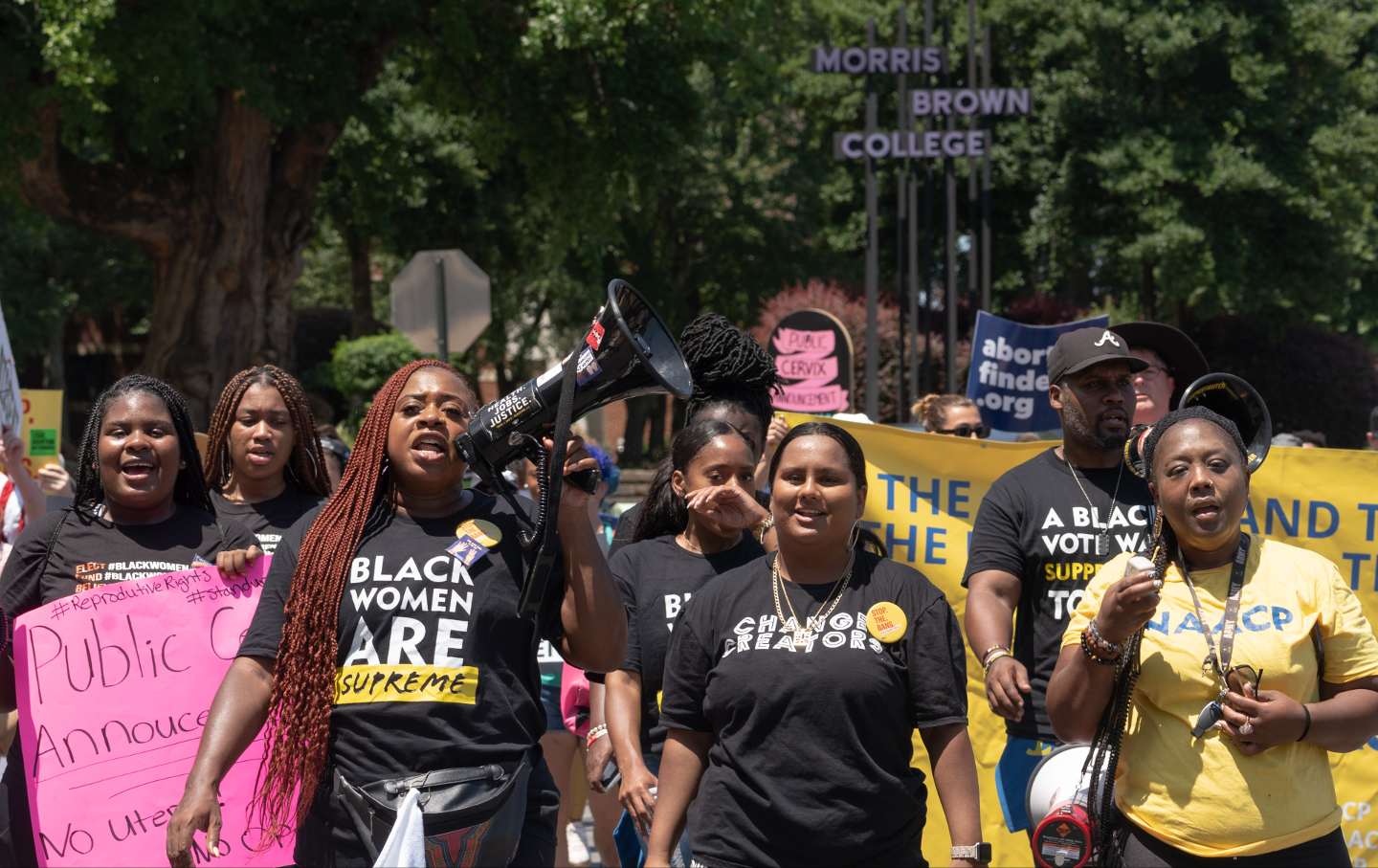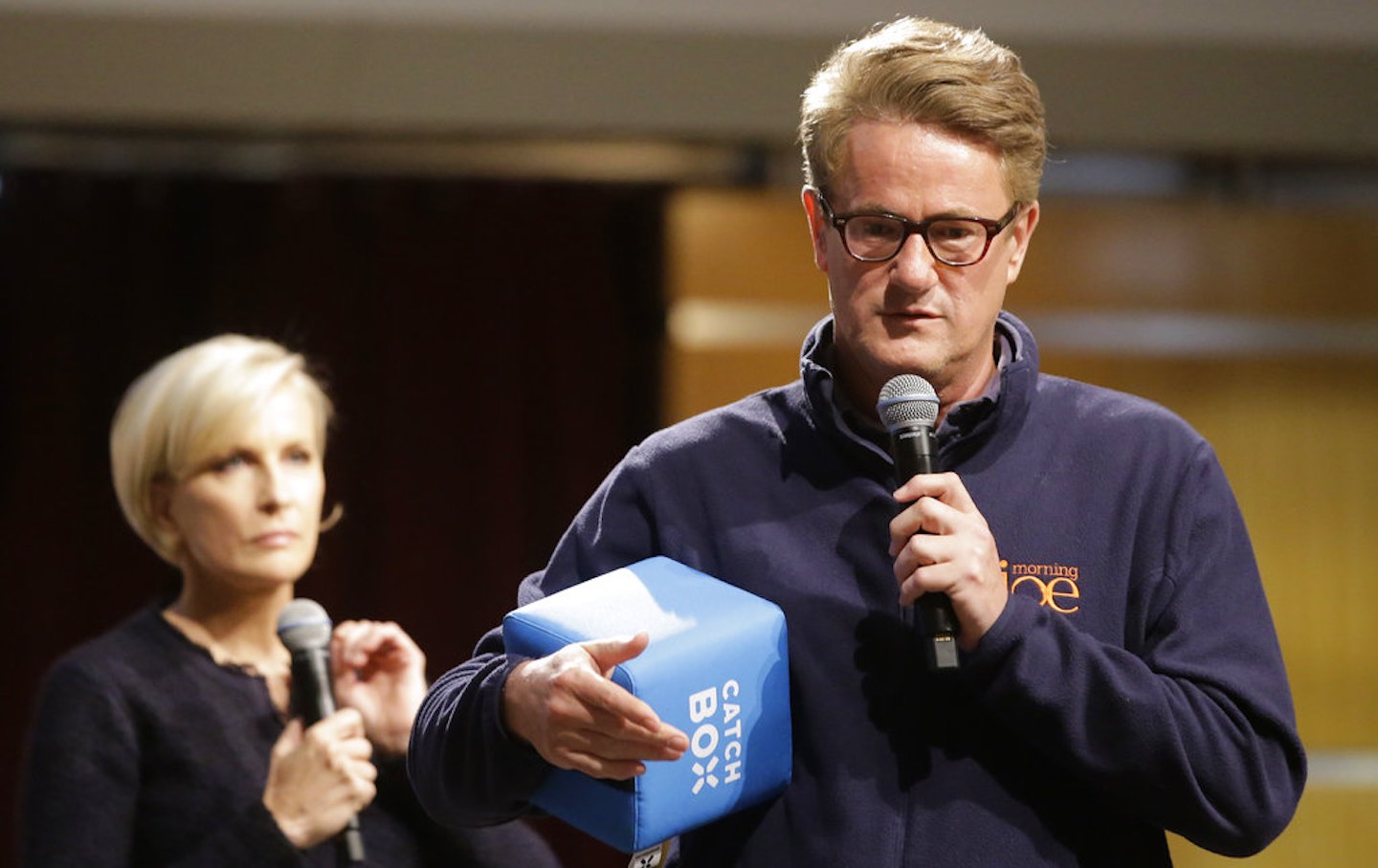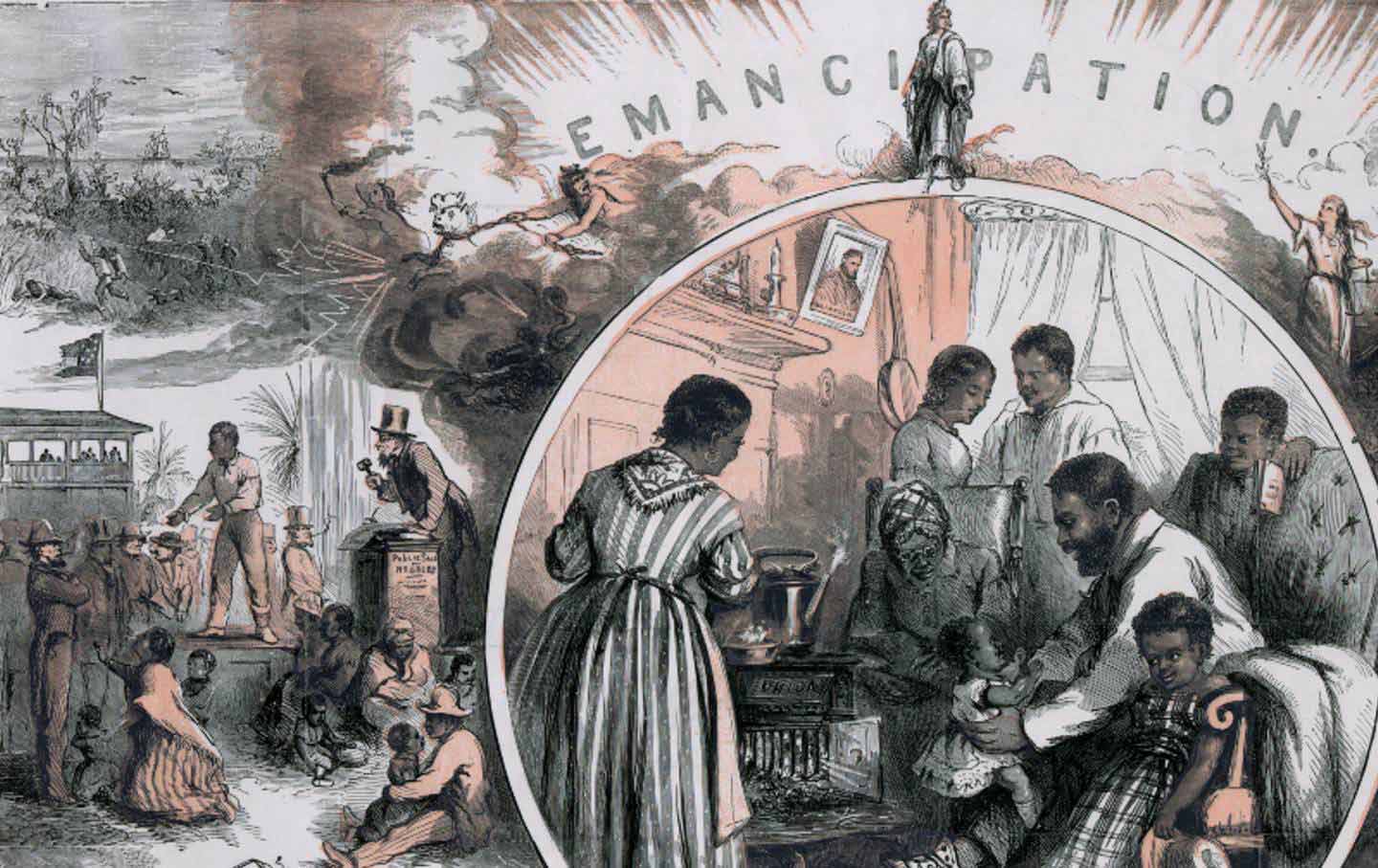An Abortion Ban Killed Amber Thurman—and Likely Many More
Will the law that killed this vibrant young woman, a mother and medical assistant, be allowed to stand?

Protesters march in downtown Atlanta in July 2022 in opposition to Georgia’s post-Dobbs abortion ban.
(Megan Varner / Getty Images)
Since the Supreme Court overturned Roe two years ago, many of us have been holding our breaths, waiting for our dead woman.
Now we know her name.
It’s Amber Nicole Thurman.
She was 28 and worked as a medical assistant and had a 6-year-old son whom she loved to take to petting zoos and the beach. As was horribly predictable, in a country where Black women seek abortions at higher rates and die far more commonly from maternal-health complications, she was Black. She died because doctors in Georgia did not perform a routine procedure to remove tissue retained after a medication abortion. She had wanted a procedural abortion in Georgia, but was forced by the state’s six-week ban to travel four hours away to North Carolina, where she missed her appointment because of standstill traffic. The clinic offered her a medication abortion instead; at nine weeks, she was well within the standard of care for that treatment. The complication she suffered is rare and can be treated with a routine procedure. She died because her home state of Georgia had made that routine procedure a felony.
Now her son is starting a new school year without her.
Related Article
ProPublica reported Thurman’s death Monday. It’s the first confirmed case after Dobbs where an abortion ban killed a woman. What’s most striking to me, beyond the sheer tragedy of her death, is how much work it took to confirm it. Reporter Kavitha Surana combed through death records and coroners’ reports to find cases that seemed related to abortion access. She first reached out to Thurman’s loved ones a year ago. Eventually, she obtained a document where the state’s maternal mortality review committee spelled out in black and white that Thurman’s death was “preventable.” On Wednesday ProPublica reported on a second death from Georgia’s abortion ban—that of Candi Miller, who had been warned her health was so fragile that another pregnancy could kill her. In 2022, when she became pregnant, Miller ordered abortion medication online. She experienced the same rare complication as Thurman, but she was afraid to seek care because of the state’s abortion ban. Instead, she took painkillers and suffered at home, until her husband found her unresponsive in bed with her 3-year-old daughter by her side. Given what it took to confirm that these deaths resulted from a ban, as Surana writes, “There are almost certainly others.” How many deaths have we not heard about, because finding them requires such intensive reporting?
In January, The New Yorker’s Stephania Taladrid reported on a young woman from Texas who had died two weeks after Roe was overturned from pregnancy-related complications, asking, as the headline read: “Did an Abortion Ban Cost a Young Texas Woman Her Life?” It was hard to say for sure, although it seemed the answer was yes. Yeni Glick, an aspiring scientist and certified nursing aide, suffered from health conditions, including hypertension, diabetes, and a history of pulmonary edema, that made pregnancy riskier for her. Undoubtedly, these conditions were complicated by the fact that she couldn’t afford the needed medications and prenatal care, but, as Taladrid reported, when Glick’s health collapsed during an acute hypertensive episode, her providers never gave her the option of an abortion, and she died awaiting transfer to a larger hospital. Glick’s death involved larger, structural failures like poverty and lack of healthcare access, and doubtless, many of the post-Dobbs deaths we’ve all been expecting are like hers—not the result of any one policy. They are no less tragic because of that.
It is hard to isolate the death of a young woman of color from these compounding causes in a country with the highest maternal mortality rate in the developed world. It is rare that an official document turns up that declares a death “preventable.”
But in Amber Thurman’s case, it happened. Hers is a rare case of a death we can lay squarely at the feet of a particular law. The question now is whether her death will lead to change. Will she become a rallying cry, like Savita Halappanavar, whose death after she was denied an abortion while miscarrying helped bring about the repeal of Ireland’s nationwide abortion ban? Or, like dead women from eras of lost abortion rights past, will she haunt us like a ghost, reminding our country of its failures?
I’ve been digging into the deaths of women from abortion bans for a book on the history of the anti-abortion movement, and what I’ve found so far is that anti-abortion policies tend to endure even after they’ve been traced to a woman’s death.
In 1977, Rosie Jimenez died as a direct result of the Hyde Amendment, the ban on federal funding of abortion passed in 1976. A young mother and student in South Texas, she had had two abortions before the Hyde Amendment cut off her access under Medicaid. So she went to a midwife who performed an abortion in unsterile conditions, and she contracted a terrible infection. She suffered for days in agony and left behind a daughter who grew up without a mom. We only know these facts because of the reporting of the late feminist journalist Ellen Frankfort and abortion rights activist Frances Kissling, who traveled to McAllen, Texas, and spoke to the women who knew Rosie. If not for their reporting, Rosie may have been remembered as just another Latina who went across the border for an abortion out of shame, as a Washington Post article headlined “Doubts Arise About Abortion Martyr” put it. Like Surana at ProPublica, Kissling and Frankfort were able to draw a direct line between a woman’s death and the policy that killed her, which they ultimately documented in their book Rosie: The Investigation of a Wrongful Death.
The book is now out of print, and the Hyde Amendment is still law of the land. While efforts to repeal Hyde are finally gaining mainstream traction, we’ll never know how many more Rosies are out there whom we never learned about.
In 1988, Becky Bell died at the age of 17 as a direct result of Indiana’s parental consent law. When she discovered that she was pregnant, she went to Planned Parenthood, where she learned that to get an abortion she would need parental consent or a waiver from a judge. But the judge who would have considered Becky’s case was known to be anti-abortion. Fearing that she would disappoint her parents if she told them she was pregnant, Becky found a way to end the pregnancy without telling them. She died of pneumonia from an infection caused by unsterile instruments. We only know her story because her parents, an all-American couple who had been homecoming king and queen a year apart at the same high school, decided to go public with the secret their daughter took to her grave.
Today, Indiana is one of 14 states that ban abortion outright. We’ll never know how many more Beckys are out there whose names we never learned.
Will the policy that killed Amber Thurman be allowed to stand?
The answer depends in part on the election. Georgia is a key swing state where voting rights activists have been working overtime to combat voter suppression and keep the state blue. (Voters there narrowly chose Biden and sent two Democratic senators to Washington in 2020). Vice President Kamala Harris released a statement Monday that lay the blame for Thurman’s death on Trump, saying, “This young mother should be alive, raising her son, and pursuing her dream of attending nursing school,” and she has called attention many times to the threat abortion bans pose to pregnant people’s health and lives. But there’s more to do. If I were advising Harris, I’d tell her to hold a press conference in Thurman’s hometown with a photograph of this vibrant young woman and lay her death at the feet of Republican policymakers. Perhaps such an event would help bolster local Democrats in the state who could do something about the law that killed Amber Thurman.
“Reproductive Justice advocates have been sounding the alarm for years about abortion restrictions leading to worse maternal health and emergency reproductive care outcomes,” Regina Davis Moss of In Our Own Voice said in a statement. “In Our Own Voice’s recent poll found that 40% of Black women of reproductive age feel less safe and are unsure if they want to have kids as a result of the Dobbs decision.”
Popular
“swipe left below to view more authors”Swipe →Beyond this election, Thurman’s legacy will depend on reproductive health and justice activists, who on Monday responded to her death with a resounding sense of outrage that was even more profound because they all knew this day was coming.
Monica Simpson, executive director of SisterSong, echoed the sentiment: “This is the reality of being a Black woman seeking care in an anti-abortion America. We are dying.”
As ProPublica reported, attorneys for the state of Georgia had chosen to ignore these warnings. When advocates tried to block the six-week ban that killed Amber Thurman by voicing concerns that it would endanger women, the lawyers accused them of “hyperbolic fear mongering.” Two weeks later, Amber was dead.
The ban did exactly what we all knew it was going to do.
But the sheer predictability of her death should deepen, rather than dampen, our outrage.
We cannot back down
We now confront a second Trump presidency.
There’s not a moment to lose. We must harness our fears, our grief, and yes, our anger, to resist the dangerous policies Donald Trump will unleash on our country. We rededicate ourselves to our role as journalists and writers of principle and conscience.
Today, we also steel ourselves for the fight ahead. It will demand a fearless spirit, an informed mind, wise analysis, and humane resistance. We face the enactment of Project 2025, a far-right supreme court, political authoritarianism, increasing inequality and record homelessness, a looming climate crisis, and conflicts abroad. The Nation will expose and propose, nurture investigative reporting, and stand together as a community to keep hope and possibility alive. The Nation’s work will continue—as it has in good and not-so-good times—to develop alternative ideas and visions, to deepen our mission of truth-telling and deep reporting, and to further solidarity in a nation divided.
Armed with a remarkable 160 years of bold, independent journalism, our mandate today remains the same as when abolitionists first founded The Nation—to uphold the principles of democracy and freedom, serve as a beacon through the darkest days of resistance, and to envision and struggle for a brighter future.
The day is dark, the forces arrayed are tenacious, but as the late Nation editorial board member Toni Morrison wrote “No! This is precisely the time when artists go to work. There is no time for despair, no place for self-pity, no need for silence, no room for fear. We speak, we write, we do language. That is how civilizations heal.”
I urge you to stand with The Nation and donate today.
Onwards,
Katrina vanden Heuvel
Editorial Director and Publisher, The Nation
More from The Nation

Mr. Scarborough Goes to Mar-a-Lago Mr. Scarborough Goes to Mar-a-Lago
The hosts of Joe Biden’s favorite political talk show have quickly pivoted to kissing the ring of the incoming president.

Watching a Parallel Media Try to Make Trump the Big Sports Story Watching a Parallel Media Try to Make Trump the Big Sports Story
The president-elect did not dominate the world of sports this weekend, but Fox News and Internet tabloids are inventing new realities.

The First Amendment Will Suffer Under Trump The First Amendment Will Suffer Under Trump
Given what’s heading our way, we need a capacious view and robust defense of the First Amendment from all quarters.

Slavery in an Age of Emancipation Slavery in an Age of Emancipation
Robin Blackburn’s sweeping history of slavery and freedom in the 19th century.

How Wisconsin Lost Control of the Strange Disease Killing Its Deer How Wisconsin Lost Control of the Strange Disease Killing Its Deer
Despite early containment efforts, chronic wasting disease has been allowed to run rampant in the state. That’s bad news for all of us.

The Prison Rodeo at the Heart of Legal Enslavement The Prison Rodeo at the Heart of Legal Enslavement
Angola prison workers make between 2 and 40 cents an hour. They also have a controversial outlet for recreation and to vend their wares at market rate: a rodeo.


